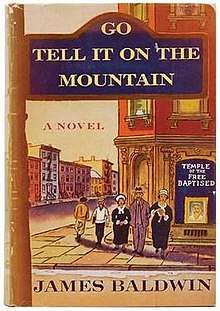Go Tell It on the Mountain (novel)
Go Tell It on the Mountain is a 1953 semi-autobiographical novel by James Baldwin. It tells the story of John Grimes, an intelligent teenager in 1930s Harlem, and his relationship to his family and his church. The novel also reveals the back stories of John's mother, his biological father, and his violent, religious fanatic stepfather, Gabriel Grimes. The novel focuses on the role of the Pentecostal Church in the lives of African-Americans, as a negative source of repression and moral hypocrisy and also as a positive source of inspiration and community. In 1998, the Modern Library ranked Go Tell It on the Mountain 39th on its list of the 100 best English-language novels of the 20th century. Time Magazine included the novel in its TIME 100 Best English-language Novels from 1923 to 2005.[2]
 First edition | |
| Author | James Baldwin |
|---|---|
| Country | United States |
| Language | English |
| Genre | Semi-autobiographical novel |
| Publisher | Knopf |
Publication date | May 18, 1953[1] |
| ISBN | 0-440-33007-6 (Paperback edition) |
| OCLC | 24659110 |
| LC Class | PS3552 .A5 G6 |
References to other works
Baldwin makes several references to the Bible in Go Tell It on the Mountain, most importantly to the story of Ham, Noah’s son who saw his father naked one day. Noah consequently cursed Ham’s son Canaan to become the servant of Noah’s other sons.
Baldwin refers to several other people and stories from the Bible, at one point alluding to the story of Moses leading the Israelites out of Egypt, and drawing a parallel to that exodus and the need for a similar exodus for African-Americans out of their subservient role in which whites have kept them. John's wrestling with Elisha evokes the story of Jacob wrestling with a mysterious supernatural being in Genesis.
The rhythm and language of the story draw heavily on the language of the Bible, particularly of the King James Version. Many of the passages use the patterns of repetition identified by scholars such as Robert Alter and others as being characteristic of Biblical poetry.[3]
Major themes
James Baldwin grew up in Harlem and never knew his biological father. His Baptist minister stepfather was "Brooding, silent, tyrannical ... and physically abusive, he was also a storefront preacher of morbid intensity."[4] Also like John, Baldwin underwent a religious awakening at the age of 14, when Baldwin became a Pentecostal preacher. His later novels expressed his growing disillusionment with church life, and they also feature homosexual and bisexual themes.[4]
John is a confused adolescent boy. He cannot look at anything without having it painted in the light of the church. According to the church, he is committing sin because of his own nature, which is the cause of his confusion.
The story includes racial injustice, both as a background theme, and in one flashback sequence as leading to John's biological father's (Richard's) suicide. Richard had been wrongly imprisoned and beaten, despite having proclaimed his innocence.
Film, TV or theatrical adaptations
The Public Broadcasting Service produced a made-for-television movie based on Go Tell It on the Mountain in 1984. Stan Lathan directed the film, with Paul Winfield starring as Gabriel in his adulthood and Ving Rhames playing Gabriel in his youth.[5] Baldwin was pleased with the adaptation, saying in an interview with The New York Times, "I am very, very happy about it [...] It did not betray the book."[6]
The work was translated into French in 1957 by Henri Hell and Maud Vidal under the title Les Élus du Seigneur.
References
- "Books Published Today". The New York Times: 19. May 18, 1953.
- "All-Time 100 Novels". Time. October 16, 2005.
- Robert Alter, The Art of Biblical Poetry, Basic Books, 1987
- Anderson, Michael (March 29, 1998). "Trapped Inside James Baldwin". The New York Times. Retrieved September 6, 2015.
- Internet Movie Database
- Bennetts, Leslie (January 10, 1985). "James Baldwin Reflects On 'Go Tell It' PBS Film". The New York Times. Retrieved February 13, 2018.